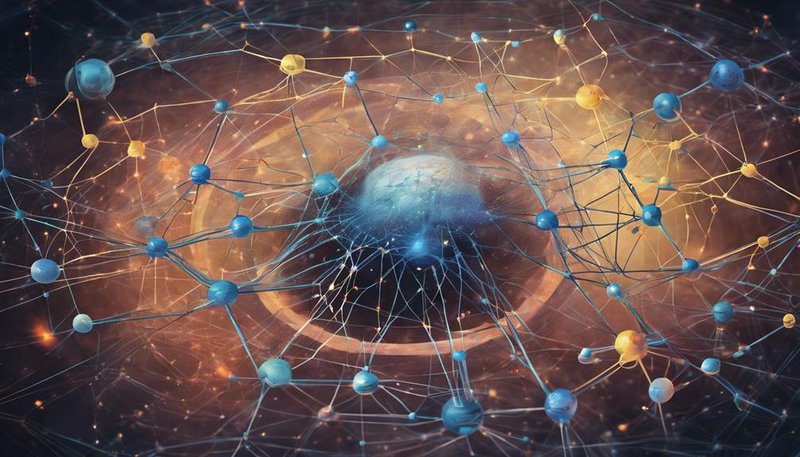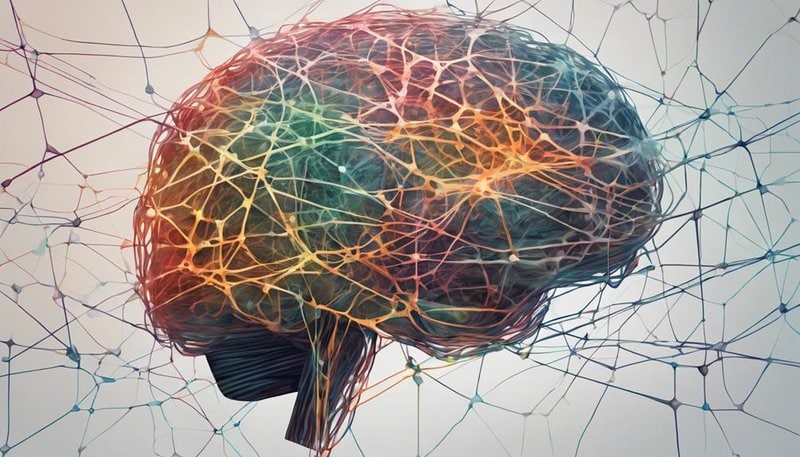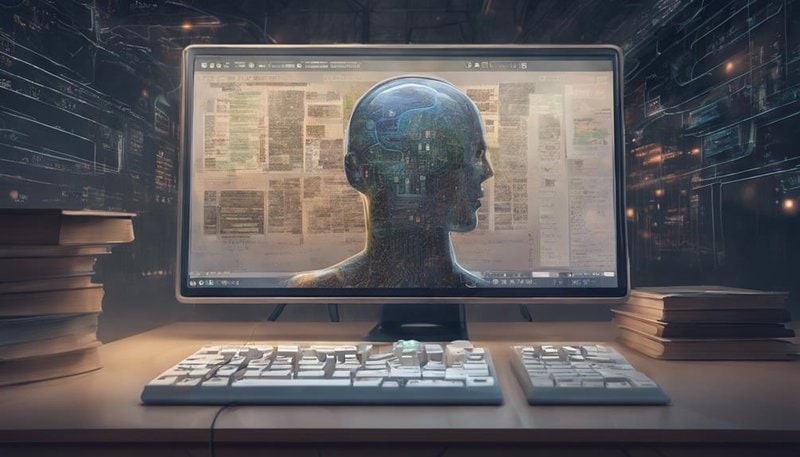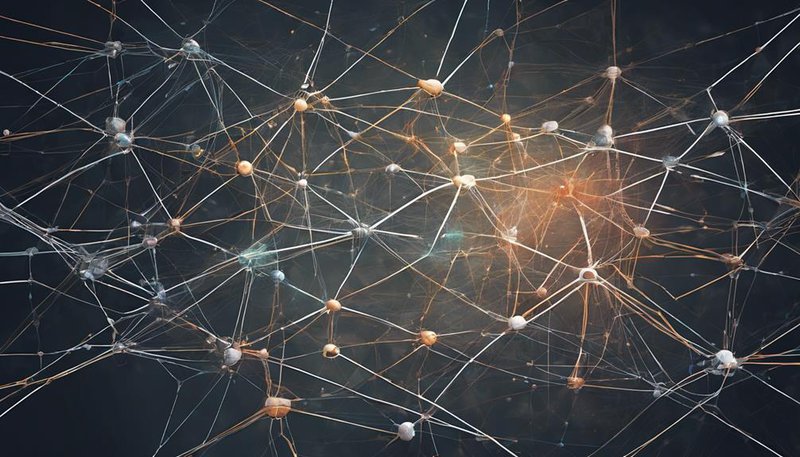What Is Artificial Intelligence (Ai) and How Does It Work

Artificial Intelligence is a complex system that mimics human cognition through neural networks, machine learning, and computer vision. It works by integrating these components to process data, learn from it, and make decisions without human intervention.
AI has the potential to revolutionize various industries by automating tasks and improving efficiency, paving the way for a future where machines can think and act like humans.
Definition of Artificial Intelligence
To comprehend the essence of Artificial Intelligence, one must grasp its fundamental definition as the simulation of human intelligence processes by machines. AI capabilities encompass a wide range of functions that enable machines to mimic cognitive functions such as learning, problem-solving, perception, reasoning, and language understanding. Machine intelligence, a core component of AI, allows systems to analyze data, recognize patterns, and make decisions with minimal human intervention.
The power of AI capabilities lies in its ability to process vast amounts of information swiftly and efficiently, providing insights and predictions that can revolutionize industries and enhance daily life. Machine intelligence isn’t limited by human constraints such as fatigue or bias, allowing for unbiased and consistent decision-making processes.
Understanding the definition of Artificial Intelligence opens doors to a world where machines can augment human capabilities, automate repetitive tasks, and unblock new worlds of innovation. Embracing AI capabilities holds the key to a future where freedom isn’t hindered by limitations but empowered by the endless possibilities that machine intelligence offers.
Key Takeaways
- AI simulates human intelligence through neural networks and machine learning.
- It processes data, learns autonomously, and makes decisions.
- AI revolutionizes industries by enabling machines to think and act like humans.
- AI’s potential applications include healthcare, finance, transportation, and more.

History of AI Development
Embarking on a journey through the annals of AI development reveals a tapestry of innovation and ingenuity that has shaped the evolution of machine intelligence. The history of AI is rich with the contributions of visionaries and inventors who paved the way for the intelligent systems we see today.
- AI pioneers: Individuals like Alan Turing, John McCarthy, and Marvin Minsky laid the groundwork for artificial intelligence through their groundbreaking research and theoretical frameworks.
- Key advancements: Milestones such as the creation of the first neural networks, expert systems, and IBM’s Deep Blue defeating a world chess champion showcased the progress of AI technology over the years.
- Impact on society, ethical concerns: As AI continues to advance, its impact on society raises ethical concerns regarding privacy, job displacement, bias in algorithms, and the potential for autonomous weapons. These considerations prompt reflection on the responsible development and deployment of artificial intelligence systems.
The history of AI development serves as a testimony to human innovation and serves as a cautionary tale for navigating the complexities of intelligent machines with wisdom and foresight.
Types of Artificial Intelligence
As you begin the journey into the exploration of Types of Artificial Intelligence, it’s essential to understand the distinct levels that AI can operate at and the various applications across industries.
Explore the intricacies of how different levels of AI, from narrow to general intelligence, impact the capabilities of technology.
Discover the multitude of ways AI is transforming sectors like healthcare, finance, and transportation, showcasing its versatility and potential.
Levels of AI
Explore into the intricate layers of Artificial Intelligence by investigating the various levels that encompass this fascinating field of technology.
When delving into the levels of AI, consider the following:
- Narrow AI: Specialized in performing specific tasks, like voice assistants.
- General AI: Possesses human-like intelligence and can handle a wide range of tasks.
- Superintelligent AI: Surpasses human intelligence, potentially leading to unforeseen consequences.
Understanding these levels is essential for grasping the potential of AI ethics and capabilities. Each level presents unique challenges and opportunities, emphasizing the need for responsible development and deployment.
As you navigate through the levels of AI, remember the importance of ethical considerations and the immense capabilities that this technology offers.
Applications of AI
To comprehend the breadth of Artificial Intelligence’s impact, one must first discern the diverse applications that manifest in various types of AI.
AI in healthcare revolutionizes patient care through predictive analytics and personalized medicine, enhancing diagnoses and treatment plans.
In finance, AI streamlines processes, offering insights for better investment decisions and fraud detection.
AI in transportation optimizes routes, reduces congestion, and enhances safety through autonomous vehicles.
In agriculture, AI boosts crop yield by analyzing data on soil health, weather patterns, and crop diseases, aiding farmers in making informed decisions.
These applications showcase the versatility and transformative power of Artificial Intelligence across sectors, shaping a future where innovation and efficiency converge to benefit society in profound ways.
Machine Learning Basics
Explore the fundamental principles of machine learning to grasp the essence of its power and potential.
Machine learning operates on the premise that systems can automatically learn and improve from experience without being explicitly programmed. Here are some key aspects to contemplate:
- Data Analysis: Machine learning thrives on data – the more data available, the better the model can learn and make accurate predictions. It involves processing and analyzing large datasets to extract meaningful patterns and insights.
- Predictive Modeling: Through predictive modeling, machine learning algorithms can make predictions based on patterns identified in historical data. This allows for forecasting future outcomes with a high degree of accuracy.
- Algorithm Training: Central to machine learning is the process of training algorithms using labeled data to enable them to make decisions or predictions when new, unseen data is presented.
Neural Networks and Deep Learning

Now, let’s journey into the intricate domain of neural networks and deep learning.
You’ll explore the fundamental workings of neural networks, grasp the intricate concepts of deep learning, and uncover the diverse applications that neural networks power.
Prepare to unravel the complexities and expose the potential of these cutting-edge technologies.
Basics of Neural Networks
Explore into the foundational principles of Neural Networks, essential components of the intricate world of Deep Learning. Neural network architecture forms the backbone, consisting of layers that process and transform data. Training algorithms are the guiding force, adjusting the network’s weights to enhance performance.
- Layers: Imagine these as interconnected nodes, each layer extracting specific features.
- Weights: Picture these as the strength of connections between nodes, essential for accurate predictions.
- Activation Function: Visualize this as the element introducing non-linearity, enabling complex learning.
Understanding these elements illuminates the path to mastering Neural Networks, empowering you in the domain of Deep Learning.
Deep Learning Concepts
Explore into the world of Deep Learning through the intricate concepts of Neural Networks and their pivotal role in modern artificial intelligence.
Data visualization techniques play a critical role in understanding the complex patterns that neural networks uncover from vast datasets.
Optimization algorithms lie at the heart of deep learning, allowing these networks to learn and improve over time by minimizing errors.
Deep learning applications span across various fields, from healthcare to finance, revolutionizing how tasks are automated and insights are derived.
Embrace the power of neural networks in unlocking the potential of AI, where patterns emerge from data, and decisions become more precise. Delve deeper into the realms of deep learning, where innovation knows no bounds.
Neural Network Applications
Enter on a profound journey into the domain of artificial intelligence by delving into the diverse applications of neural networks, particularly in the domain of deep learning.
Within the domain of neural network applications, two standout functionalities captivate the imagination:
- Image Recognition: Witness the magic as neural networks decipher complex patterns and shapes, enabling machines to identify objects and scenes with remarkable accuracy.
- Speech Synthesis: Explore the art of transforming text into lifelike speech, as neural networks master the nuances of language and intonation, creating a seamless auditory experience.
- Pattern Recognition: Experience the power of neural networks in detecting intricate patterns within data, revolutionizing fields like finance, healthcare, and more.
Enter into the depths of neural networks and witness the wonders of AI unfold before you.
Natural Language Processing (NLP)

Delving into the intricate world of Natural Language Processing (NLP) allows you to unravel the intricacies of human language interaction and comprehension through artificial intelligence. NLP empowers machines to comprehend, interpret, and generate human language, enabling remarkable applications such as chatbots for seamless language understanding.
These chatbots engage in meaningful conversations, providing assistance and information as if interacting with a human. Additionally, NLP plays a pivotal role in sentiment analysis, where it discerns emotions and opinions expressed in text. Through sentiment analysis, businesses can gauge customer feedback, monitor brand perception, and make data-driven decisions.
Furthermore, NLP excels in text generation, creating coherent and contextually relevant content. This capability finds utility in diverse areas like content creation, language translation, and personalized recommendations. Embracing NLP in AI opens a world of possibilities where language becomes a bridge between humans and machines, fostering understanding and connection in this digital age.
Computer Vision and AI
Expose the profound impact of Computer Vision on the domain of Artificial Intelligence, where machines perceive and interpret visual information akin to human vision. Image recognition, a key component of this field, allows machines to identify objects, scenes, and even emotions in images through the power of machine learning.
Visual perception plays a crucial role in enabling machines to understand and interact with the visual world, paving the way for advancements in various industries like healthcare, automotive, and security. Deep learning techniques further enhance computer vision capabilities by enabling algorithms to learn intricate patterns and features from vast amounts of visual data, mimicking the complexity of the human visual system.
Embracing the synergy between computer vision and AI opens doors to innovative applications that revolutionize how we interact with technology, bridging the gap between the physical and digital domains seamlessly.
AI Algorithms and Decision Making

As you venture into the domain of AI algorithms and decision-making,
keep in mind the intricate dance between data processing and intelligent choices.
Embrace the elegance of AI algorithm basics as they pave the way
for sophisticated decision-making processes.
Expose the power of AI in shaping our future through strategic computations and insightful conclusions.
AI Algorithm Basics
To grasp the essence of AI Algorithm Basics, one must explore into the intricate world where algorithms govern decision-making processes with precision and foresight. In this domain, Ai algorithm optimization and machine learning techniques intertwine, shaping the very fabric of AI’s capabilities. Through meticulous data preprocessing, the algorithms sift through vast amounts of information, distilling it into actionable insights. Model evaluation acts as the gatekeeper, ensuring that only the most refined algorithms make important decisions.
Imagine this:
- Ai algorithms optimizing themselves like a sculptor hones a masterpiece
- Machine learning techniques unraveling patterns like threads in a grand tapestry
- Data preprocessing as the alchemist turning raw data into knowledge
In this landscape, the power of AI algorithms lies in their ability to navigate complexity with grace and efficiency.
Decision-Making Processes
Enter on a journey through the domain of AI algorithms and decision-making, where intricate processes unfold with precision and impact.
When delving into decision-making algorithms, one must consider the critical aspect of AI ethics and the ethical implications that arise from automated decision-making. AI bias, inherent in these algorithms, can have a substantial impact on the outcomes and fairness of decisions made by artificial intelligence systems.
Understanding how AI algorithms operate in decision-making processes is essential to mitigate potential biases and guarantee ethical standards are upheld.
As you navigate this domain, be mindful of the responsibility that comes with developing and implementing these algorithms, aiming for a balance between innovation and ethical considerations to foster a future where AI serves society equitably.
Ethics and Challenges in AI
Exploring the intricate landscape of artificial intelligence, one must confront the ethical dilemmas and formidable challenges that accompany its rapid advancement. In the domain of AI, ethical implications and bias challenges stand as monumental obstacles that require careful consideration and proactive solutions.
- Ethical Implications: The use of AI raises profound ethical questions regarding privacy, accountability, and the potential consequences of autonomous decision-making systems.
- Bias Challenges: Addressing bias in AI algorithms is essential to make sure fairness and prevent discrimination in areas such as hiring processes, loan approvals, and criminal justice systems.
- Transparency and Accountability: Establishing transparent processes and mechanisms for accountability is essential to build trust in AI systems and mitigate the risks associated with their deployment.
Exploring the ethical complexities and challenges in AI demands a steadfast commitment to upholding values of fairness, transparency, and accountability. As we tread this path, it’s imperative to approach these issues with a critical eye and a dedication to creating a future where AI serves as a force for good.
Future of Artificial Intelligence

In envisioning the future of artificial intelligence, ponder the boundless horizons that await, where innovation and possibility intersect in a domain of endless potential. As AI continues to advance, the ethical considerations surrounding its use become increasingly crucial. It is imperative to guarantee that AI development aligns with ethical principles, safeguarding against potential misuse or harm. Simultaneously, the necessity for robust AI regulation grows to maintain accountability and transparency in this rapidly evolving field.
To navigate the intricate landscape of AI’s future, a harmonious balance between innovation and responsibility must be struck. Here is a glimpse into the key facets shaping the future of artificial intelligence:
| Future of AI | Key Aspects |
|---|---|
| AI Ethics | Ensuring responsible AI development and usage |
| AI Regulation | Implementing frameworks to govern AI practices |
| Technological Advancements | Harnessing cutting-edge technologies for AI progress |
| Ethical Dilemmas | Addressing moral implications of AI decisions |
| Societal Impact | Understanding the broader consequences of AI integration |
Embracing the future of artificial intelligence entails embracing not just its capabilities but also the ethical and regulatory frameworks that will define its trajectory.
Frequently Asked Questions
Can AI Be Used to Predict the Future?
Yes, AI can indeed be used to predict the future. By harnessing its powerful capabilities in future forecasting through predictive analytics, AI advancements continue to push the boundaries of what is possible in anticipating upcoming trends and events.
How Do AI Algorithms Impact Job Opportunities in Various Industries?
In various industries, AI algorithms are reshaping job opportunities. Job automation is on the rise, emphasizing the need for skills training. Economic implications demand workforce adaptation. Embrace change, prepare for the future.
What Are the Potential Risks of Using AI in Healthcare?
In healthcare, using AI poses potential risks. Ethical implications arise from decision-making algorithms. Data privacy concerns persist regarding patient information. You must navigate these challenges wisely and guarantee transparency to safeguard against unintended consequences.
How Is AI Being Used in the Field of Climate Change Research?
In the domain of climate change research, AI works wonders. It assists in environmental modeling by analyzing vast datasets, tackling issues like carbon footprints. Machine learning thrives in this field, offering insights that propel sustainability efforts forward.
Is There a Limit to How Intelligent AI Can Become?
You contemplate if AI can reach limitless intelligence. Ethical boundaries guide its path. Technological advancements fuel progress. Remember, the quest for conscious machines may challenge us. Embrace the unknown but respect the boundaries.








